Increased in vivo inhibition of gene expression by combining RNA interference and U1 inhibition
- PMID: 22086952
- PMCID: PMC3245954
- DOI: 10.1093/nar/gkr956
Increased in vivo inhibition of gene expression by combining RNA interference and U1 inhibition
Abstract
Inhibition of gene expression can be achieved with RNA interference (RNAi) or U1 small nuclear RNA-snRNA-interference (U1i). U1i is based on U1 inhibitors (U1in), U1 snRNA molecules modified to inhibit polyadenylation of a target pre-mRNA. In culture, we have shown that the combination of RNAi and U1i results in stronger inhibition of reporter or endogenous genes than that obtained using either of the techniques alone. We have now used these techniques to inhibit gene expression in mice. We show that U1ins can induce strong inhibition of the expression of target genes in vivo. Furthermore, combining U1i and RNAi results in synergistic inhibitions also in mice. This is shown for the inhibition of hepatitis B virus (HBV) sequences or endogenous Notch1. Surprisingly, inhibition obtained by combining a U1in and a RNAi mediator is higher than that obtained by combining two U1ins or two RNAi mediators. Our results suggest that RNAi and U1i cooperate by unknown mechanisms to result in synergistic inhibitions. Analysis of toxicity and specificity indicates that expression of U1i inhibitors is safe. Therefore, we believe that the combination of RNAi and U1i will be a good option to block damaging endogenous genes, HBV and other infectious agents in vivo.
Figures
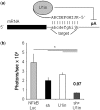
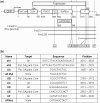
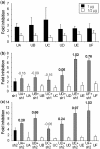

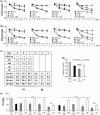
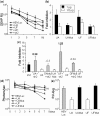


Similar articles
-
Combination of RNA interference and U1 inhibition leads to increased inhibition of gene expression.Nucleic Acids Res. 2010 Jul;38(13):e136. doi: 10.1093/nar/gkq299. Epub 2010 Apr 28. Nucleic Acids Res. 2010. PMID: 20427423 Free PMC article.
-
U1 interference (U1i) for antiviral approaches.Adv Exp Med Biol. 2015;848:51-69. doi: 10.1007/978-1-4939-2432-5_3. Adv Exp Med Biol. 2015. PMID: 25757615 Review.
-
U1 snRNP control of 3'-end processing and the therapeutic application of U1 inhibition combined with RNA interference.Curr Mol Med. 2013 Aug;13(7):1203-16. doi: 10.2174/1566524011313070012. Curr Mol Med. 2013. PMID: 23278451 Review.
-
Requirements for gene silencing mediated by U1 snRNA binding to a target sequence.Nucleic Acids Res. 2008 Apr;36(7):2338-52. doi: 10.1093/nar/gkn068. Epub 2008 Feb 24. Nucleic Acids Res. 2008. PMID: 18299285 Free PMC article.
-
AAV-mediated in vivo knockdown of luciferase using combinatorial RNAi and U1i.Gene Ther. 2011 Sep;18(9):929-35. doi: 10.1038/gt.2011.41. Epub 2011 Apr 7. Gene Ther. 2011. PMID: 21472008 Free PMC article.
Cited by
-
Alternative polyadenylation of tumor suppressor genes in small intestinal neuroendocrine tumors.Front Endocrinol (Lausanne). 2014 Apr 15;5:46. doi: 10.3389/fendo.2014.00046. eCollection 2014. Front Endocrinol (Lausanne). 2014. PMID: 24782827 Free PMC article.
-
Emerging Roles of RNA 3'-end Cleavage and Polyadenylation in Pathogenesis, Diagnosis and Therapy of Human Disorders.Biomolecules. 2020 Jun 17;10(6):915. doi: 10.3390/biom10060915. Biomolecules. 2020. PMID: 32560344 Free PMC article. Review.
-
Long Non-Coding RNA BST2/BISPR is Induced by IFN and Regulates the Expression of the Antiviral Factor Tetherin.Front Immunol. 2015 Jan 9;5:655. doi: 10.3389/fimmu.2014.00655. eCollection 2014. Front Immunol. 2015. PMID: 25620967 Free PMC article.
-
U1A is a positive regulator of the expression of heterologous and cellular genes involved in cell proliferation and migration.Mol Ther Nucleic Acids. 2022 May 10;28:831-846. doi: 10.1016/j.omtn.2022.05.023. eCollection 2022 Jun 14. Mol Ther Nucleic Acids. 2022. PMID: 35664701 Free PMC article.
-
Alterations in polyadenylation and its implications for endocrine disease.Front Endocrinol (Lausanne). 2013 May 8;4:53. doi: 10.3389/fendo.2013.00053. eCollection 2013. Front Endocrinol (Lausanne). 2013. PMID: 23658553 Free PMC article.
References
-
- Rivas FV, Tolia NH, Song JJ, Aragon JP, Liu J, Hannon GJ, Joshua-Tor L. Purified Argonaute2 and an siRNA form recombinant human RISC. Nat. Struct. Mol. Biol. 2005;12:340–349. - PubMed
-
- Gunderson SI, Polycarpou-Schwarz M, Mattaj IW. U1 snRNP inhibits pre-mRNA polyadenylation through a direct interaction between U1 70K and poly(A) polymerase. Mol. Cell. 1998;1:255–264. - PubMed
-
- Fortes P, Cuevas Y, Guan F, Liu P, Pentlicky S, Jung SP, Martinez-Chantar ML, Prieto J, Rowe D, Gunderson SI. Inhibiting expression of specific genes in mammalian cells with 5' end-mutated U1 small nuclear RNAs targeted to terminal exons of pre-mRNA. Proc. Natl Acad. Sci. USA. 2003;100:8264–8269. - PMC - PubMed

